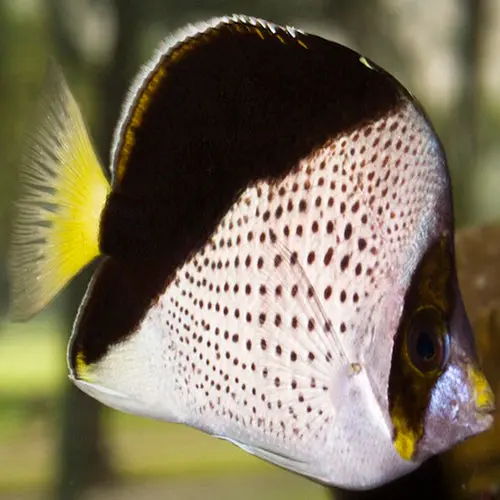The Hawaiian Butterflyfish (Chaetodon tinkeri), also known as Tinker’s Butterflyfish, is a striking marine species admired for its distinctive coloration and adaptability in aquarium settings.
Key Information
• Small fish safe: Yes
• Small invert safe: ⚠️ With caution
• Coral safe: No
• Minimum tank size: 454 liters (120 gallons)
• Adult size: Up to 15 cm (5.9 inches)
• Diet: Carnivorous, feeding on planktonic and benthic organisms.
• Be aware of: May nip at corals and small invertebrates; requires a well-established tank with ample live rock for grazing and hiding; can exhibit territorial behavior, especially towards similar species.
Appearance and Coloration
The Hawaiian Butterflyfish features a distinctive diagonal coloration, with the anterior portion of its body being white adorned with black spots on each scale, and the posterior part being black. It has shades of yellow and orange marking the face, dorsal fin, and tail. A prominent gold vertical bar runs across its eyes, adding to its striking appearance.
Natural Habitat and Behavior
In the wild, Chaetodon tinkeri inhabits steep slopes near black corals at depths ranging from 27 to over 150 meters. They are typically found alone, in pairs, or occasionally in small aggregations. Their natural diet consists of a variety of planktonic and benthic organisms.
Tank Requirements and Water Parameters
To ensure the well-being of the Hawaiian Butterflyfish in captivity:
• Minimum Tank Size: A 120-gallon (454 liters) aquarium is recommended to provide ample space for swimming and territory establishment.
• Water Parameters:
• Temperature: 22°C – 26°C (72°F – 78°F)
• pH: 8.1 – 8.4
• Specific Gravity: 1.020 – 1.025
• Aquascaping: Incorporate abundant live rock to create hiding spots and grazing areas, mimicking their natural reef habitat.
• Lighting: Moderate lighting is suitable.
• Water Movement: Moderate flow to simulate their natural environment.
Maintaining stable water conditions and high water quality is crucial for their health. A mature, well-established aquarium with abundant live rock will support their natural grazing behavior and provide necessary shelter.
Diet and Feeding
Hawaiian Butterflyfish are carnivorous and adapt well to captive diets:
• Diet: Offer a varied diet consisting of:
• Enriched mysis shrimp
• Enriched brine shrimp
• Other meaty items
• Feeding Frequency: Feed small amounts multiple times daily to meet their nutritional needs.
Providing ample live rock will allow natural grazing behavior, which is beneficial for their health and well-being. Initially, they may be shy and reluctant to eat; offering live or frozen foods can encourage feeding until they become accustomed to prepared foods.
Compatibility and Social Structure
Hawaiian Butterflyfish can exhibit territorial behavior, especially towards conspecifics and similar species:
• Social Structure: Best kept singly unless in a very large aquarium where multiple individuals can establish territories.
• Temperament: Generally peaceful towards other species but may become aggressive towards similar-looking fish.
• Compatible Tank Mates: Suitable companions include peaceful community fish such as gobies, blennies, and wrasses. Caution is advised when housing with other butterflyfish or species with similar coloration.
Observing their interactions and providing ample space can help mitigate aggressive behaviors. Due to their territorial nature, they should be housed with non-aggressive tank mates to prevent stress.
Important Considerations
• Reef Compatibility: While often considered reef-safe, individual specimens may nip at corals and clam mantles. Monitoring their behavior is essential, especially in reef setups.
• Acclimation: They may be shy upon introduction but typically become more confident over time.
• Health: Ensure a varied diet and stable water conditions to prevent common health issues.
With proper care and attention to their specific needs, Hawaiian Butterflyfish can be a vibrant and rewarding addition to a marine aquarium.
